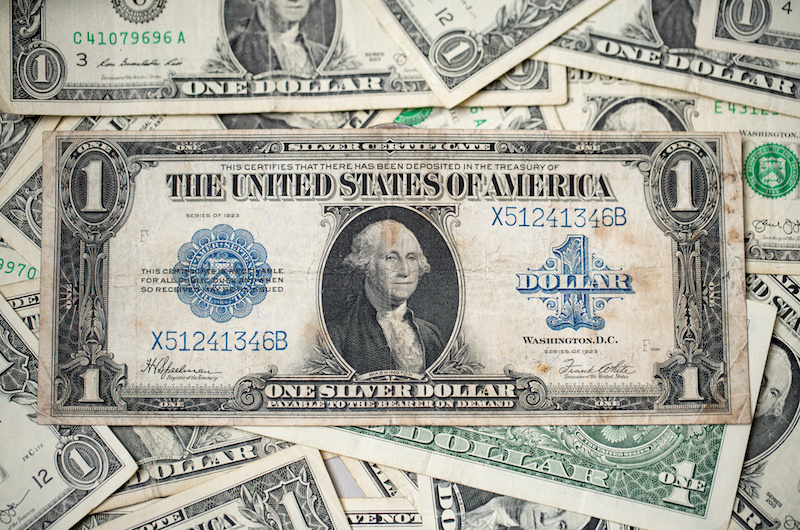The silver certificate was a type of representative money issued by the United States from 1878 to 1964. These certificates were some of the country’s first forms of paper money.
When silver certificates were first issued by the U.S. government in the 19th century, they were redeemable for their face value equivalent in silver dollar coins. Most typically, Morgan Dollar coins early on, then Peace Dollars. Though it is possible to have exchanged the certificates for any combination of silver coins, including dimes, quarters and half dollars as well.
As silver coins were being transitioned from the economy the Treasury stopped providing an exchange in silver coins. Instead, silver certificates were exchanged for raw silver bullion.
In 1968, the U.S. government halted the redemption of silver certificates for silver bullion entirely. While silver certificates are technically still fiat legal tender, most often they are kept as collector’s items or keepsakes, with some having significant numismatic value in certain conditions.
Key Facts About Silver Certificates
- Silver certificates are a former legal tender paper currency that was issued by the U.S. government beginning in 1878.
- Each certificate represented the face value amount in silver bullion, enabling individuals to carry and use paper currency for all the same transactions as silver and gold coins.
- The Treasury Secretary declared that silver certificates would no longer be redeemable for silver dollars in 1964.
- Silver certificates can still be redeemed for their face value in fiat currency today, however, many have historical and numismatic value beyond the face value.
Understanding Silver Certificates
On the front of each silver certificate, the following phrase was printed: “This certifies that there is on deposit in the Treasury of the United States of America X dollars in silver payable to the bearer on demand.” The ‘X’ represents the denomination of the certificate that ranged from $1 to $1,000.
When silver certificates were first introduced, silver and gold coins were considered to be real money. The value of each coin was based on the amount of silver that it was minted with. Each $1 USD silver coin has a gross weight of 26.73 g, with a silver content of 0.7734 ozt.
This means that for every ten Morgan Dollar coins someone was carrying, the weight of those coins was 8.6 troy ounces, a little more than half a pound. With the introduction of paper money, the same amount of silver value could be carried with just a few folded pieces of paper.
The key characteristic that helped insure that people adopted the use of silver certificates is that they were backed and guaranteed by the US Treasury and could be redeemed at anytime for the equivalent amount of silver coins.
Value of Silver Certificates
With precious metals removed from the economy completely in the early 1970s, modern U.S. currency, including paper bills and coins, is now fiat money with no underlying commodity providing backing.
This includes both Federal Reserve Notes and the no-longer-issued silver certificates, as neither are currently redeemable for a set amount of a silver or gold.
The value of individual silver certificate as numismatic collectibles can vary widely based on their age, condition, rarity, and specific print run, among other factors. Some are particularly valuable, especially specimens in good condition or with certain serial numbers, with many examples of PCGS graded large denomination silver certificates fetching hundreds of dollars.
Silver certificates continue to have strong appeal among silver stackers, currency collectors and those who appreciate the history and nostalgia they represent. They serves as a historical artifact that is a reminder of an era when silver was integrally woven into the fabric of the economy and how changes occur in the currency system regularly.
